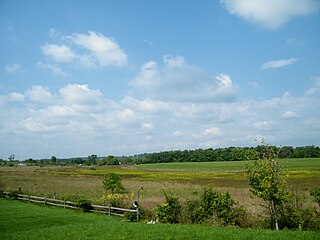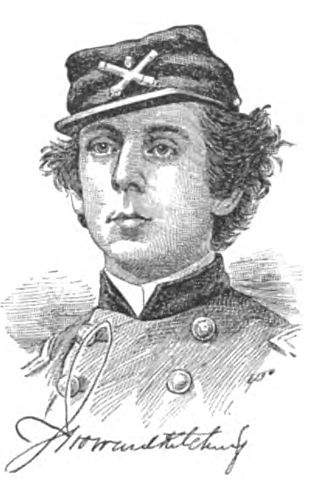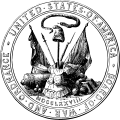
George R. Crook was a career United States Army officer who served in the American Civil War and the Indian Wars. He is best known for commanding U.S. forces in the 1886 campaign that led to the defeat of the Apache leader Geronimo. As a result, the Apache nicknamed Crook Nantan Lupan, which means "Chief Wolf."

The Army of the Shenandoah was a field army of the Union Army active during the American Civil War. First organized as the Department of the Shenandoah in 1861 and then disbanded in early 1862, the army became most effective after its recreation on August 1, 1864 under the command of Philip Sheridan. The army's actions during the Valley campaigns of 1864 rendered the Shenandoah Valley of Virginia unable to produce foodstuffs for the Confederate States Army, a condition which would hasten the conclusion of the American Civil War.

The Battle of Cedar Creek, or Battle of Belle Grove, was fought on October 19, 1864, during the American Civil War. The fighting took place in the Shenandoah Valley of Northern Virginia, near Cedar Creek, Middletown, and the Valley Pike. During the morning, Lieutenant General Jubal Early appeared to have a victory for his Confederate army, as he captured over 1,000 prisoners and over 20 artillery pieces while forcing seven enemy infantry divisions to fall back. The Union army, led by Major General Philip Sheridan, rallied in late afternoon and drove away Early's men. In addition to recapturing all of their own artillery seized in the morning, Sheridan's forces captured most of Early's artillery and wagons.

The Third Battle of Winchester, also known as the Battle of Opequon or Battle of Opequon Creek, was an American Civil War battle fought near Winchester, Virginia, on September 19, 1864. Union Army Major General Philip Sheridan defeated Confederate Army Lieutenant General Jubal Early in one of the largest, bloodiest, and most important battles in the Shenandoah Valley. Among the 5,000 Union casualties were one general killed and three wounded. The casualty rate for the Confederates was high: about 4,000 of 15,500. Two Confederate generals were killed and four were wounded. Participants in the battle included two future presidents of the United States, two future governors of Virginia, a former vice president of the United States, and a colonel whose grandson, George S. Patton, became a famous general in World War II.

The Second Battle of Kernstown was fought on July 24, 1864, at Kernstown, Virginia, outside Winchester, Virginia, as part of the Valley Campaigns of 1864 in the American Civil War. The Confederate Army of the Valley under Lt. Gen. Jubal A. Early soundly defeated the Union Army of West Virginia under Brig. Gen. George Crook and drove it from the Shenandoah Valley back over the Potomac River into Maryland. As a result, Early was able to launch the Confederacy's last major raid into northern Union territory, attacking the Baltimore and Ohio Railroad in Maryland and West Virginia and burning Chambersburg, Pennsylvania, in retaliation for the burning of civilian houses and farms earlier in the campaign.

The Valley campaigns of 1864 began as operations initiated by Union Lieutenant General Ulysses S. Grant and resulting battles that took place in the Shenandoah Valley of Virginia during the American Civil War from May to October 1864. Some military historians divide this period into three separate campaigns. This article considers them together, as the campaigns interacted and built upon one another.
The Battle of Cool Spring, also known as Castleman's Ferry, Island Ford, Parker's Ford, and Snicker's Ferry, was a battle in the American Civil War fought July 17–18, 1864, in Clarke County, Virginia, as part of the Valley Campaigns of 1864. The battle was a Confederate victory.

The VI Corps was a corps of the Union Army during the American Civil War.

The VIII Corps was a corps of the Union Army during the American Civil War.
The Army of the Valley was the name given to the army of Lt. Gen. Jubal Early's independent command during the Shenandoah Valley Campaigns in the summer and autumn of 1864. The Army of the Valley was the last Confederate unit to invade Northern territory, reaching the outskirts of Washington, D.C. The Army became defunct after its decisive defeat at the Battle of Waynesboro, Virginia, on March 2, 1865.
The 23rd Ohio Infantry Regiment was an infantry regiment in the Union Army during much of the American Civil War. It served in the Eastern Theater in a variety of campaigns and battles, and is remembered with a stone memorial on the Antietam National Battlefield not far from Burnside's Bridge.
The following Union Army units and commanders fought in the Battle of Cedar Creek of the American Civil War. The battle was fought on October 19, 1864. Order of battle compiled from the army organization during the campaign. The Confederate order of battle is listed separately.
The 5th West Virginia Infantry Regiment was an infantry regiment that served in the Union Army during the American Civil War.
The 9th West Virginia Infantry Regiment was an infantry regiment that served in the Union Army during the American Civil War.

The Second Corps of the Army of Northern Virginia was a military organization within the Confederate Army of Northern Virginia during much of the American Civil War. It was officially created and named following the Battle of Sharpsburg in 1862, but comprised units in a corps organization for quite some time prior to that. The Second Corps developed a reputation for hard fighting under famed early commander Thomas J. "Stonewall" Jackson.
Joseph Thoburn was an Irish-born American officer and brigade commander in the Union Army during the American Civil War. An accomplished physician and soldier from the state of West Virginia, he was killed in action in the Shenandoah Valley at the Battle of Cedar Creek.

John Howard Kitching often referred to as J. Howard Kitching, was an officer in the Union Army during the American Civil War. He served in the cavalry, artillery and infantry in the Army of the Potomac and Army of the Shenandoah. He received a posthumous promotion to brevet brigadier general after being mortally wounded at the Battle of Cedar Creek.
The Kanawha Division was a Union Army division which could trace its origins back to a brigade originally commanded by Jacob D. Cox. This division served in western Virginia and Maryland and was at times led by such famous personalities as George Crook and Rutherford B. Hayes.
The following Union Army units and commanders fought in the Third Battle of Winchester in the American Civil War. The Confederate order of battle is listed separately. The battle was fought on September 19, 1864 near Winchester, Virginia, and Opequon Creek. The battle is also known as the Battle of Opequon or the Battle of Opequon Creek.

The 45th Virginia Infantry Regiment was an infantry regiment raised in the Commonwealth of Virginia for service in the Confederate States Army during the American Civil War. It fought mostly in the mountainous area that today encompasses the border regions of Virginia and West Virginia, and was part of Jubal Early's Army of the Valley during the Valley Campaigns of 1864.











